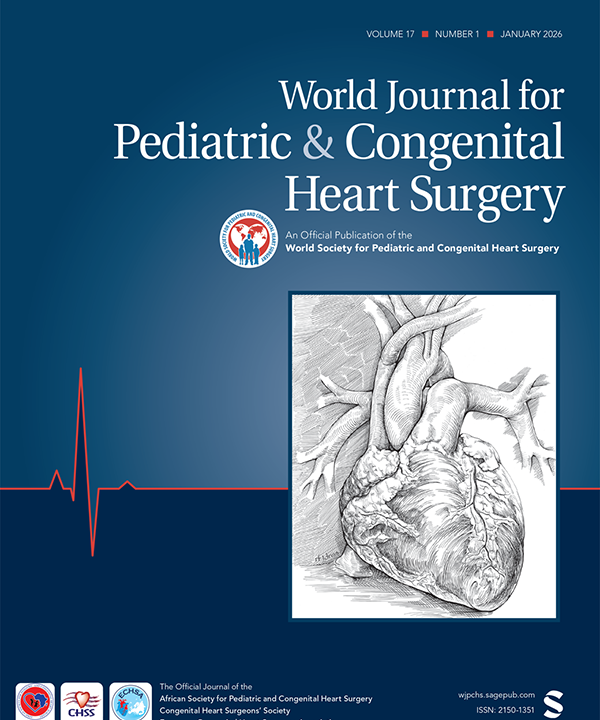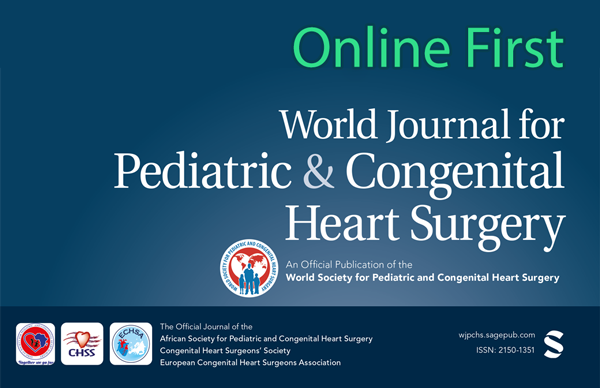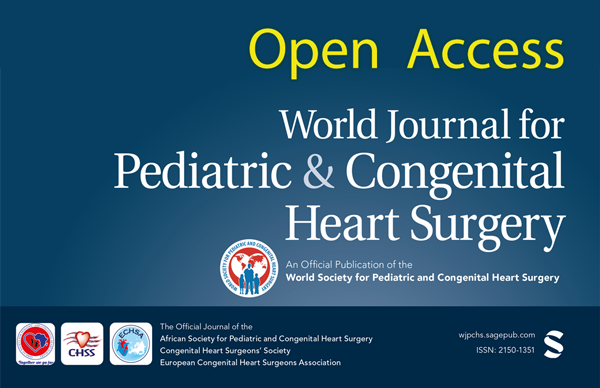Highlights of the 18th International Conference on Pediatric Mechanical Circulatory Support Systems and Pediatric Cardiopulmonary Perfusion
Published: September 09, 2024.
Online first
Contributors
Robert A. Niebler; Akif Undar
World Journal for Pediatric and Congenital Heart Surgery, Ahead of Print.
The 18th International Conference on Pediatric Mechanical Circulatory Support Systems and Pediatric Cardiopulmonary Perfusion was held in Milwaukee, WI, USA, on May 9 and 10, 2024. The conference was hosted by the Herma Heart Institute of Children’s Wisconsin at the Pfister Hotel in downtown Milwaukee. This communication provides the highlights of the proceedings.
Read this article | Join for full access
The Anatomy and Embryology of Tetralogy of Fallot With Pulmonary Atresia
Published: September 06, 2024.
Online first
Contributors
Vera D. Aiello
World Journal for Pediatric and Congenital Heart Surgery, Ahead of Print.
In this review, we approach the main morphologic and developmental aspects of the congenital cardiovascular malformation known as tetralogy of Fallot with pulmonary atresia. It is recognized that pulmonary atresia associated with a deficient ventricular septation can occur in several situations. However, the tetralogy presentation in particular, with frequent but not invariable concomitance of systemic-to-pulmonary collateral arteries supplying the lungs entirely or in part, poses surgical challenges. The variations in the morphology of such collateral arteries and the intracardiac anatomy are discussed.
Read this article | Join for full access
Impact of Atrioventricular Valve Intervention at Each Stage of Single Ventricle Palliation
Published: September 06, 2024.
Online first
Contributors
John D. Vossler; Aaron W. Eckhauser; Eric R. Griffiths; Reilly D. Hobbs; Linda M. Lambert; Lloyd Y. Tani; Niharika Parsons; Robert H. Habib; Jeffrey P. Jacobs; Marshall L. Jacobs; S. Adil Husain
World Journal for Pediatric and Congenital Heart Surgery, Ahead of Print.
Background: Significant atrioventricular valve dysfunction can be associated with mortality or need for transplant in functionally univentricular heart patients undergoing staged palliation. The purposes of this study are to characterize the impact of concomitant atrioventricular valve intervention on outcomes at each stage of single ventricle palliation and to identify risk factors associated with poor outcomes in these patients. Methods: The Society of Thoracic Surgeons Congenital Heart Surgery Database was queried for functionally univentricular heart patients undergoing single ventricle palliation from 2013 through 2022. Separate analyses were performed on cohorts corresponding to each stage of palliation (1: initial palliation; 2: superior cavopulmonary anastomosis; 3: Fontan procedure). Bivariate analysis of demographics, diagnoses, comorbidities, preoperative risk factors, operative characteristics, and outcomes with and without concomitant atrioventricular valve intervention was performed. Multiple logistic regression was used to identify predictors associated with operative mortality or major morbidity. Results: Concomitant atrioventricular valve intervention was associated with an increased risk of operative mortality or major morbidity for each cohort (cohort 1: 62% vs 46%, P < .001; cohort 2: 37% vs 19%, P < .001; cohort 3: 22% vs 14%, P < .001). Black race in cohort 1 (odds ratio [OR] 3.151, 95% CI 1.181-9.649, P = .03) and preterm birth in cohort 2 (OR 1.776, 95% CI 1.049-3.005, P = .032) were notable predictors of worse morbidity or mortality. Conclusions: Concomitant atrioventricular valve intervention is a risk factor for operative mortality or major morbidity at each stage of single ventricle palliation. Several risk factors are associated with these outcomes and may be useful in guiding decision-making.
Read this article | Join for full access
The World Society for Pediatric and Congenital Heart Surgery: 2024 Update of the World Database for Pediatric and Congenital Heart Surgery
Published: September 06, 2024.
Online first
Contributors
James D. St Louis; Craig S. Collum; John K. Pennington; Taylor Broser; Rama Rudraraju; Maceo Cleggett; Jeanne Anne Love; Patricia Potter; Brian Bateson; Ignacio Juaneda; Jorge Luis Cervantes; Cheul Lee; Jeffery P Jacobs; Erle H. Austin; James K. Kirklin
World Journal for Pediatric and Congenital Heart Surgery, Ahead of Print.
BackgroundThe World Database for Pediatric and Congenital Heart Surgery (WDPCHS), sponsored by the World Society for Pediatric and Congenital Heart Surgery (WSPCHS), provides complex congenital heart surgery outcomes analyses for member programs. This report represents the seven-year descriptive analysis of outcomes from active members of the WDPCHS.MethodsIndividual institutions submit data based on the specific procedure via a password protected platform. The data are collected, stored, and analyzed at Kirklin Solutions Inc., based in Birmingham, Alabama. This report presents a descriptive analysis of these procedures submitted from January 1, 2017, to December 31, 2023.ResultsA total of 50,174 procedures were submitted with an overall mortality of 4.6%. The majority of submissions were from Asian countries. The majority of cases submitted from these countries were of STAT mortality category I and II. Repair of a ventricular septal defect (with a mortality of 0.8%) and correction of tetralogy of Fallot (2.0% mortality) were the most common procedures submitted to the database.ConclusionsThe WSPCHS accomplished one of its missions in 2017 when the WDPCHS began accepting data from pediatric and congenital heart surgery programs across the globe. In doing so, it became one of the first organizations to create a platform for the exchange of knowledge and experience, regardless of the socioeconomic status of the particular program or country.
Read this article | Join for full access
Pulmonary Atresia and Ventricular Septal Defect Without Major Aortopulmonary Collateral Arteries: Diagnostic Evaluation and the Role of Ductal Stenting
Published: September 05, 2024.
Online first
Contributors
Jeannette R. Wong-Siegel; Christopher J. Petit; Andrew C. Glatz
World Journal for Pediatric and Congenital Heart Surgery, Ahead of Print.
Patients with pulmonary atresia (PA) and a ventricular septal defect (VSD), similar to those with tetralogy of Fallot and PA without major aortopulmonary collateral arteries, lack antegrade pulmonary blood flow, and thus require a neonatal intervention for stabilization or augmentation of pulmonary blood flow. The role of ductal stenting in the management of these patients, and the current literature supporting it, will be reviewed.
Read this article | Join for full access
Double-Outlet Right Ventricle With Intact Ventricular Septum and Left Atrioventricular Valve Regurgitation in a Patient With Right Atrial Isomerism
Published: September 05, 2024.
Online first
Contributors
Tomohiro Nakata; Maiko Tachi; Kenji Yasuda; Shigeki Nakashima; Toshiko Minamoto; Kazuhiro Yamazaki
World Journal for Pediatric and Congenital Heart Surgery, Ahead of Print.
We present a very rare case of right atrial isomerism, double-outlet right ventricle, and incomplete atrioventricular septal defect (intact ventricular septum). In the neonatal period, the right ventricle was compressed by a “blind-ended” left ventricle with mild-to-moderate left atrioventricular valve regurgitation. The regurgitation gradually decreased from mild-to-moderate to mild with body weight gain. The patient underwent systemic-to-pulmonary shunt at three months of age and bilateral bidirectional Glenn at eight months of age. Although the echocardiogram demonstrated that the right ventricle was still compressed by the left ventricle, over time the size of the left ventricle reduced significantly and the left atrioventricular valve regurgitation became trivial.
Read this article | Join for full access
Surgical Repair of Tetralogy of Fallot Using Autologous Right Atrial Appendage to Reconstruct the Right Ventricular Outflow Tract: A Case Series With Four-Year Follow-up
Published: September 05, 2024.
Online first
Contributors
Oleg Anatolyevich Egunov; Roman Sergeevich Kozhanov; Frank Cetta; Evgeny Vladimirovich Krivoshchekov
World Journal for Pediatric and Congenital Heart Surgery, Ahead of Print.
This clinical case series describes the surgical management of tetralogy of Fallot in five children using autologous right atrial appendage to reconstruct the right ventricular outflow tract. Transthoracic echocardiography performed at four-year follow-up showed a mild residual gradient and moderate regurgitation of the neopulmonary valve in all cases.
Read this article | Join for full access
Unintended Sequalae of Long-Term Transvenous Pacemaker Leads in a Patient With Congenital Heart Disease
Published: September 05, 2024.
Online first
Contributors
Soyoung Cheon; Muhammad Faateh; Awais Ashfaq
World Journal for Pediatric and Congenital Heart Surgery, Ahead of Print.
Long-term use of transvenous pacemakers, a common modality used for symptomatic bradyarrhythmias, can lead to rare but significant complications, especially in patients with congenital heart disease. We present a complex and challenging surgical lead extraction for a patient with long-standing superior vena cava syndrome resulting from prolonged transvenous leads.
Read this article | Join for full access
Predictors of Neurologic Complications and Neurodevelopmental Outcome in Pediatric Cardiac Surgery With Extracorporeal Membrane Oxygenation
Published: September 05, 2024.
Online first
Contributors
Peter Pastuszko; Michael G. Katz; Shana Ravvin; Tain-Yen Hsia; G. Praveen Raju; Vishal Nigam; Richard D. Mainwaring
World Journal for Pediatric and Congenital Heart Surgery, Ahead of Print.
Extracorporeal membrane oxygenation (ECMO) has emerged as an important intervention for children both preceding and following cardiac surgery. There is a notable lack of comprehensive information regarding neurodevelopmental outcomes. The Norwood procedure and complex biventricular repairs exhibit the highest prevalence of ECMO usage. Examination of the data demonstrates that only 50% of ECMO survivors achieved normative cognitive outcomes, with 40% of those experiencing long-term neurological deficits. It is imperative to conduct robustly designed studies with extended follow-up periods to establish guidelines for neuromonitoring and neuroprotection during ECMO in the field of congenital cardiac surgery.
Read this article | Join for full access
Outcomes Following Neonatal Cardiac Surgery in Cape Town, South Africa
Published: August 29, 2024.
Online first
Contributors
Derrik du Toit; Lenise C. Swanson; Shamiel Salie; Susan Perkins; Wisdom Basera; John B. Lawrenson; Thomas Aldersley; Andre Brooks; Liesl J. Zühlke
World Journal for Pediatric and Congenital Heart Surgery, Ahead of Print.
BackgroundNeonatal Cardiac Surgery has developed significantly since its advent, with improved outcomes, survival, and physiological repair. Limited programs offer neonatal cardiac surgery in emerging economies. We report our experience with neonates undergoing cardiac surgery in our cardiac surgery program.MethodsWe performed a secondary data analysis on all neonates aged ≤ 30 days undergoing congenital cardiac surgery from April 1, 2017 to March 31, 2020, including outcomes up to 30-days post-surgery.ResultsA total of 859 patients underwent cardiac surgery at our center, of these 81 (9.4%) were neonates. The proportion of neonates increased annually (8.7%, 9.6%, and 10.2%). There were 49 (60%) male patients, and 32 (40%) had surgery in the second week of life. Fourteen (17%) were premature, four (5%) had a major chromosomal abnormality, five (6%) a major medical illness, and eight (10%) a major noncardiac structural anomaly. The Risk Adjustment for Congenital Heart Surgery (RACHS) categorization of surgery was predominantly RACHS 3; n = 28 (35%) and 4; n = 23 (29%). Hours in the intensive care unit (ICU) were extensive; median 189 [interquartile range (IQR): 114-286] as were hours of ventilation; median 95 [IQR 45-163]. Almost 60% (n = 48) of procedures were complicated by sepsis, as defined in our database. The in-hospital mortality rate was 16% (n = 13); the 30-day mortality rate was 19.8% (n = 16).ConclusionThe proportion of neonates in our service increased over the period. Focused strategies to shorten prolonged ICU stay and decrease rates of bacterial sepsis in neonates are needed. A multidisciplinary, collaborative heart-team approach is crucial for best outcomes.
Read this article | Join for full access
Dual Decompression of the Left Atrium in Mitral Atresia With Intact Atrial Septum
Published: August 29, 2024.
Online first
Contributors
Aprateem Mukherjee; Niraj Nirmal Pandey; Lamk Kadiyani; Sivasubramanian Ramakrishnan; Priya Jagia
World Journal for Pediatric and Congenital Heart Surgery, Ahead of Print.
Read this article | Join for full access
Ross Confers More Favorable Left Ventricular Remodeling Compared With Mechanical Aortic Valve Replacement
Published: August 28, 2024.
Online first
Contributors
Garrett H. Markham; John W. Brown; Chelsea D. Wenos; Morten O. Jensen; Hanna K. Jensen; Larry W. Markham; Jeremy L. Herrmann
World Journal for Pediatric and Congenital Heart Surgery, Ahead of Print.
Background: Aortic valve disease results in left ventricular (LV) dilation and/or hypertrophy. Valve intervention may improve, but not normalize flow dynamics. We hypothesized that LV remodeling would be more favorable following the Ross procedure versus mechanical aortic valve replacement (mAVR). Methods: Patients who were 18 to 50 years of age and underwent Ross or mAVR from 2000 to 2016 at a single institution were retrospectively reviewed. Propensity score matching was performed and yielded 27 well-matched pairs. Demographics and echocardiographic variables of LV morphology and wall thickness were collected. Those with > mild residual valve disease were excluded. Primary endpoints included LV morphology. T test and Fisher exact test analysis were used for statistical comparison. Results: Average age at operation (Ross 35.3 ± 10.2 vs mAVR 37.3 ± 8.9 years) did not differ. Indication for operation was similar between groups. Preoperative echocardiographic variables did not differ. At average follow-up duration (Ross 7.9 ± 2.4 vs mAVR 7.3 ± 2.4 years), wall thickness was significantly smaller for Ross compared with mAVR (P = .00715). Only 4/27 (15%) of mAVR patients had normalized LV parameters compared with 16/27 (59%) of Ross patients (P = .000813). Residual hypertrophy was the most common long-term abnormality for mAVR. Conclusion: Following aortic valve replacement with the Ross procedure or mechanical aortic valve prosthesis, the Ross conferred more favorable LV remodeling compared with mAVR. Future directions include analyzing longer follow-up to determine if patterns persist and the impact on cardiac morbidity and mortality.
Read this article | Join for full access
The Clinical Outcomes in Patients With Atrial Isomerism Undergoing Single Ventricular Palliation: Insights From A Single-Center Study in Thailand
Published: August 28, 2024.
Online first
Contributors
Tanawat Wicheannarat; Paweena Chungsomprasong; Prakul Chanthong; Chodchanok Vijarnsorn; Supaluck Kanjanauthai; Thita Pacharapakornpong; Ploy Thammasate; Kritvikrom Durongpisitkul; Jarupim Soongswang; Teerapong Tocharoenchok; Ekarat Nitiyarom; Kriangkrai Tantiwongkosri; Thaworn Subtaweesin
World Journal for Pediatric and Congenital Heart Surgery, Ahead of Print.
Background: The management of atrial isomerism across various countries may impact survival outcomes. Methods: This retrospective study involved patients diagnosed with atrial isomerism undergoing single ventricular palliation between 2000 and 2021. The objective was to evaluate survival outcomes within the right atrial isomerism (RAI) and left atrial isomerism (LAI) groups, as well as overall survival. Results: Of the 125 patients diagnosed with atrial isomerism, 105 (84%) had RAI, and 20 (16%) had LAI. The median age at presentation was 3 days (range: birth to 7.1 years), with median follow-up of 6.6 years (range: 0.59 months to 30.8 years). In the overall cohort, survival rates at one, five, and ten years were 85.6%, 72.3%, and 66.8%, respectively, with no statistically significant difference between RAI and LAI groups (log rank P value = .293). Specifically, survival rates in the RAI group at one, five, and ten years were 83.8%, 69.0%, and 62.6%, respectively, while in the LAI group, there were 95.0%, 89.7%, and 81.6%, respectively. Following the third-stage operation, overall survival rates at one and five years were 76.4% and 76.4%, respectively. Among patients in the RAI group, survival rates at one and five years post-third stage operation were 80.2% and 80.2%, respectively. Conclusions: Despite resource limitations, the survival outcomes of patients with atrial isomerism were found to be similar with those observed in high-income countries. Although an increased mortality rate was noted within the first year of life, focusing efforts on neonatal and infant care holds potential for improving overall outcomes.




